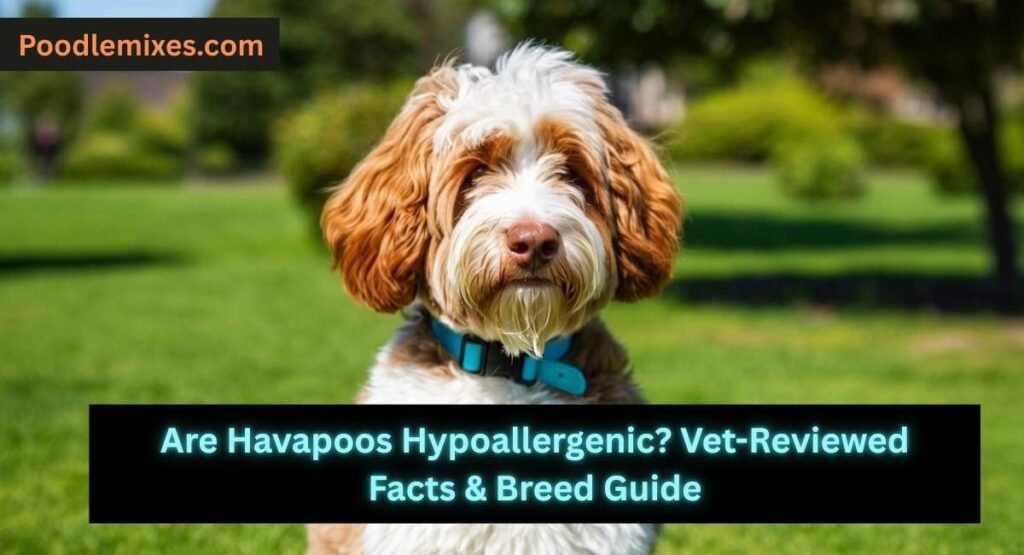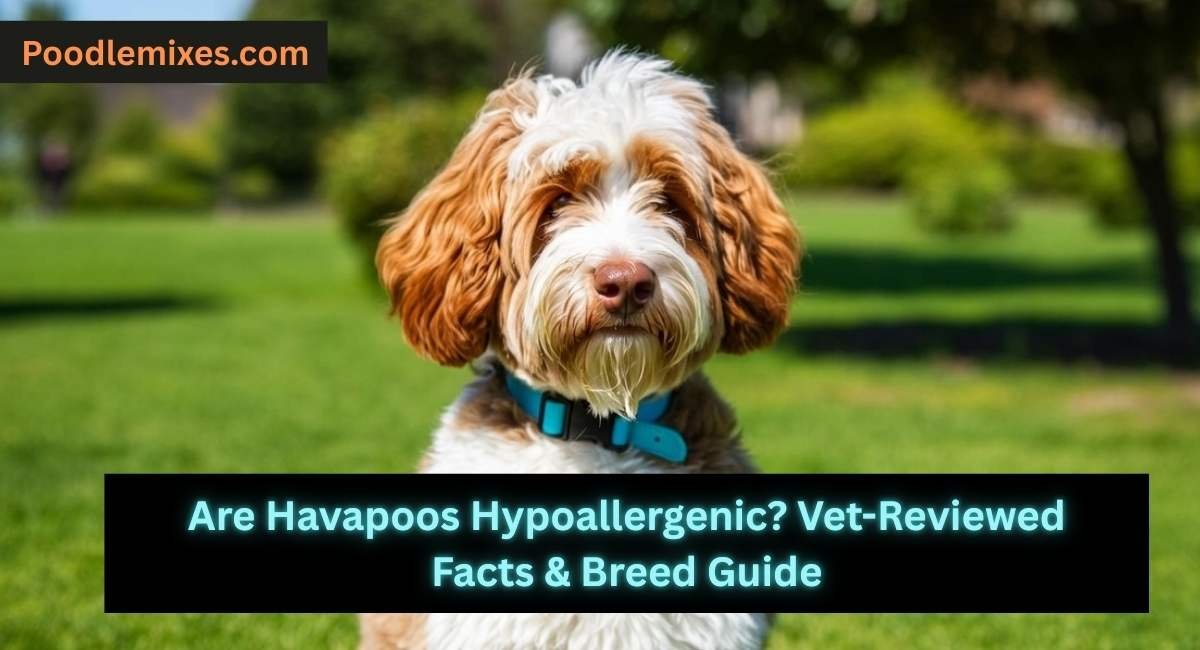Are Havapoos hypoallergenic? This delightful crossbreed, blending the affectionate Havanese with the intelligent Poodle, is frequently touted as a perfect pet for those with allergies. With both parent breeds known for their low-shedding coats, the Havapoo has a strong reputation. However, it’s crucial to begin with the expert consensus from the American College of Allergy, Asthma, and Immunology: there is no such thing as a completely hypoallergenic dog. While Havapoos are among the most suitable choices for allergy-prone owners, understanding the “why” behind this label is key to managing expectations. This guide will explore the science behind Havapoos and allergies.
Are Havapoos Hypoallergenic?
No, Havapoos are not 100% hypoallergenic, but they are considered one of the most allergy-friendly mixed breeds available. This is because both the Havanese and the Poodle have hair-like coats that shed minimally, unlike the fur of many other breeds. Since shedding is a primary mechanism for spreading dander (dead skin cells) around the home, a low-shedding dog like the Havapoo significantly reduces the amount of allergen released into the environment. However, as the American Lung Association notes, allergens are also present in saliva and urine. So, while a Havapoo may be very low-shedding, it is not allergen-free.

What Does Hypoallergenic Really Mean in Dogs?
The term “hypoallergenic” can be misleading. In a practical sense, it signifies a dog that is less likely to provoke an allergic reaction, not one that guarantees no reaction. The American Kennel Club (AKC) includes both Havanese and Poodles on its list of hypoallergenic breeds due to their non-shedding, hair-like coats that trap dander.
It’s important to balance this with scientific reality. A study in the Journal of Allergy and Clinical Immunology concluded that there is no significant difference in allergen levels between homes with “hypoallergenic” dogs and those with other dogs. This means that while a Havapoo’s coat type is advantageous, individual sensitivity and the specific dog’s allergen production are the ultimate deciding factors.
Havapoo Coat Types and Allergen Impact
The Havapoo typically inherits a soft, low-shedding coat, but the texture can vary. This texture influences how much dander is trapped and how much grooming is required.
The following chart outlines the common Havapoo coat variations:
| Coat Type | Shedding Level | Dander Control | Allergy Risk (Relative) |
|---|---|---|---|
| Curly (Poodle-Dominant) | Very Low | Excellent | Lower |
| Wavy/Silky (A Balanced Mix) | Low | Very Good | Low |
| Soft/Straight (Havanese-Dominant) | Low (but more than curly) | Good | Low to Medium |
As VCA Animal Hospitals explains, curly coats are most effective at containing dander. Fortunately, most Havapoos inherit a wavy or curly coat that is highly manageable for allergy sufferers. Their coat is also typically single-layered, unlike double-coated breeds that shed heavily, making them a relatively predictable choice.
Allergy Considerations for Havapoo Owners
The Havapoo’s small size is a significant benefit for allergy management. A smaller dog simply has less skin surface area, which can translate to lower overall dander production compared to a larger dog.
Success depends on individual circumstances. Research from the National Institutes of Health (NCBI) shows that allergen levels vary from one dog to another. For people asking “are Havapoos hypoallergenic,” the answer is positive but requires context. They are a top-tier choice, but spending time with the specific dog you plan to bring home remains the most reliable test.
Tips to Reduce Allergic Reactions With a Havapoo
Consistent grooming is the cornerstone of living happily with a Havapoo if you have allergies. Their coat requires regular maintenance to prevent matting and control dander.
- Frequent Brushing and Grooming: Brush your Havapoo every other day to remove loose hair and dander. Schedule professional grooming every 4-6 weeks for a trim and thorough cleaning. The AKC emphasizes that regular grooming is non-negotiable for non-shedding breeds.
- Regular Bathing: Bathe your Havapoo every 3-4 weeks with a gentle, hypoallergenic shampoo to wash away allergens from their skin and coat.
- Wipe Down After Adventures: Use a damp cloth to wipe your dog’s face, feet, and coat after coming indoors from walks to remove pollen and environmental allergens.
- Maintain a Clean Home Environment: Use a HEPA air purifier to capture airborne dander and vacuum frequently with a HEPA-filter machine. The EPA recommends these steps for improving indoor air quality.
- Wash Bedding Frequently: Wash your Havapoo’s bed, your own blankets, and any soft toys in hot water at least once a week.
Other Poodle Mixes Often Considered “Hypoallergenic”
Havapoos are a popular small-sized Doodle. Here’s how they compare:
| Breed | Typical Coat | Shedding Level | Allergy Friendliness* |
|---|---|---|---|
| Havapoo | Wavy/Curly | Very Low | Very High |
| Cockapoo | Curly/Wavy | Low | Higher |
| Maltipoo | Soft/Silky | Very Low | Very High |
| Westiepoo | Wiry/Curly | Very Low | Higher |
*Friendliness = relative chance of being allergy-manageable. Havapoos are consistently a top choice due to both parent breeds being low-shedding.
FAQ Section (People Also Ask)
Do Havapoos shed a lot?
No, Havapoos are very low-shedding dogs. They are considered a non-shedding breed by many standards, which is why they are so popular with people who have allergies or simply dislike vacuuming dog hair.
Are Havapoos good for people with severe allergies?
They are one of the best breeds to consider for severe allergies, but there are no guarantees. Their minimal shedding and small size are major advantages. However, anyone with severe allergies must spend extended time with a Havapoo before adoption and should consult their allergist.
What is an F1B Havapoo, and is it better for allergies?
An F1B Havapoo is a cross between an F1 Havapoo (50% Havanese, 50% Poodle) and a Poodle. This results in a puppy that is 75% Poodle. F1B Havapoos are often recommended for allergy sufferers as they are more likely to have the tight, curly Poodle coat that best traps dander.
Conclusion
So, are Havapoos hypoallergenic? While the term is not absolute, the Havapoo is arguably one of the best small mixed breeds for individuals with allergies. Their lineage from two low-shedding parents makes them a reliable and manageable choice. The path to success involves a commitment to a consistent grooming routine, maintaining a clean home, and, most importantly, personally interacting with a Havapoo before welcoming one into your family. By taking these proactive steps, allergy sufferers have a excellent chance of enjoying a wonderful life with this loving and playful companion.
